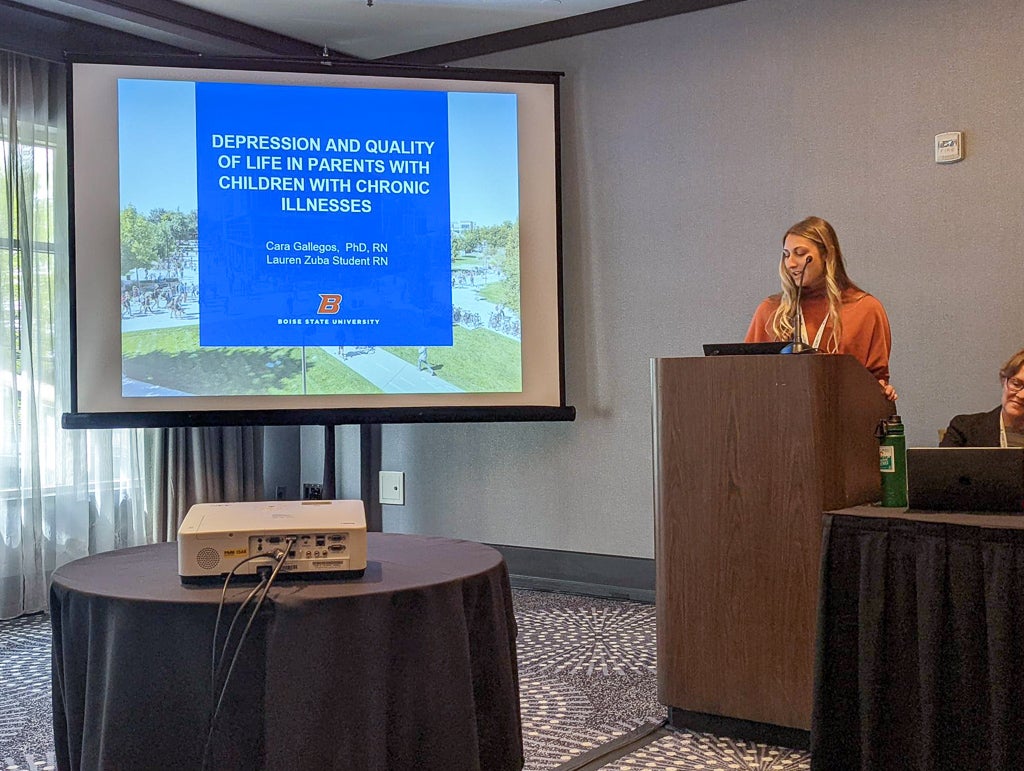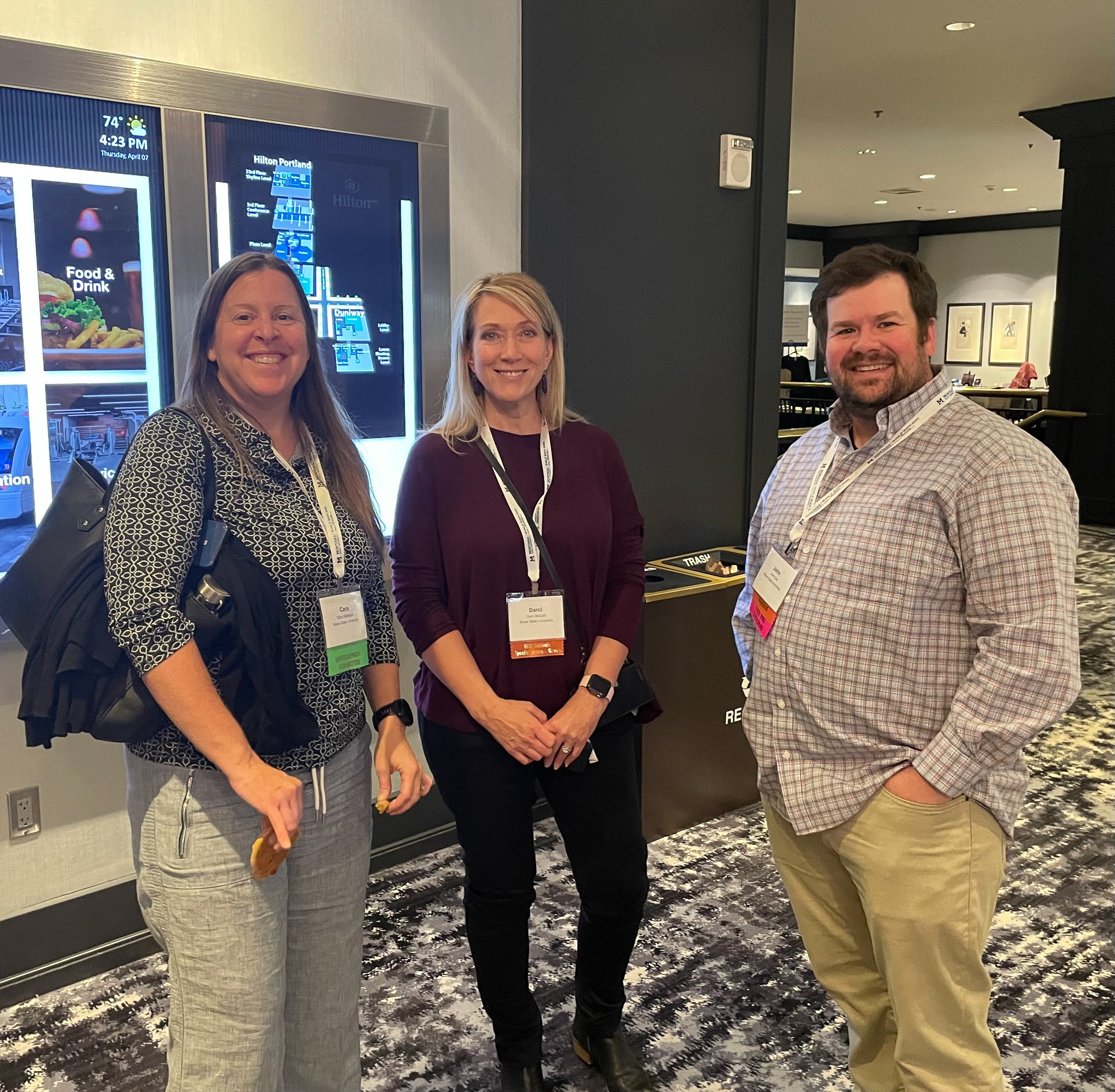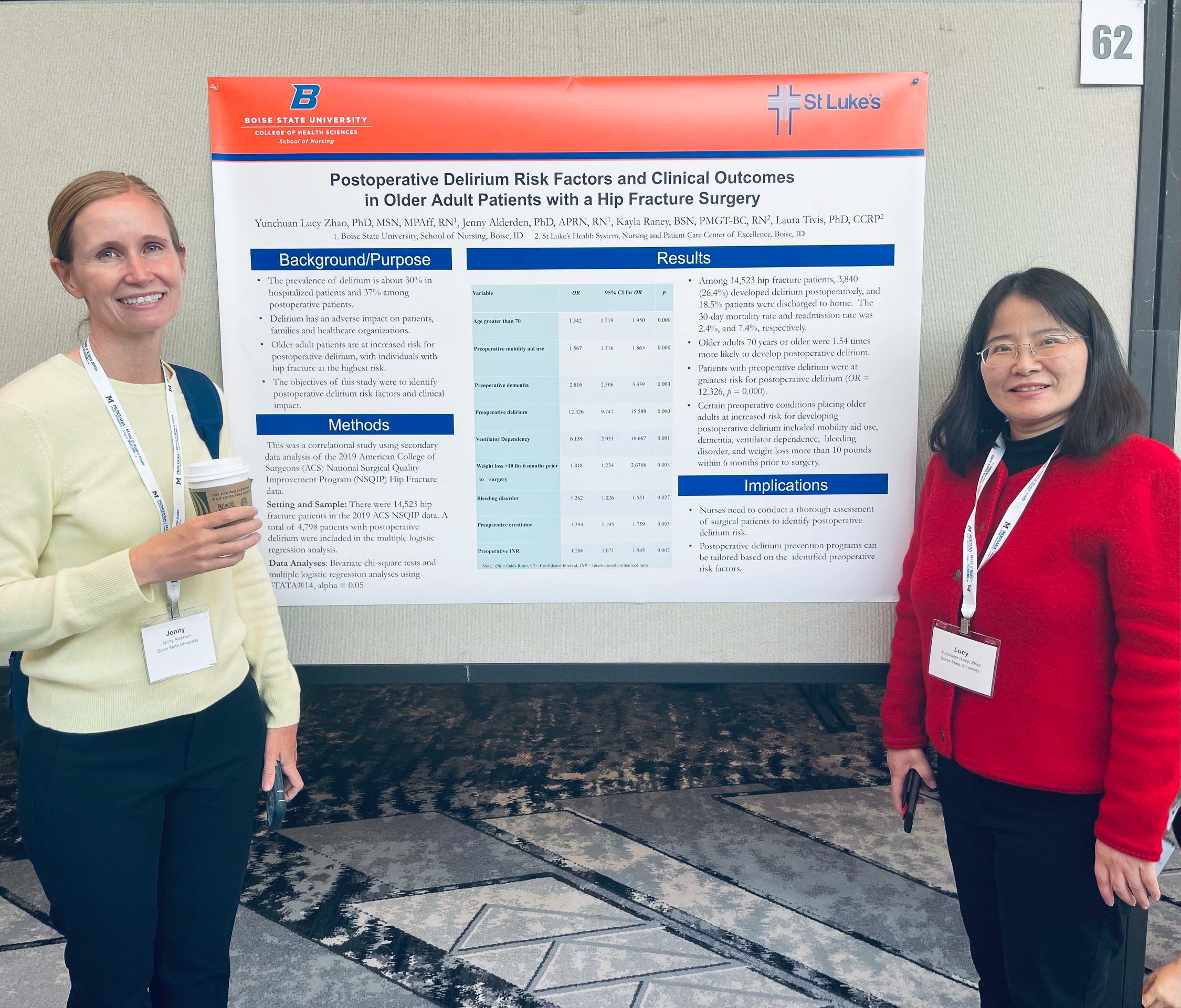
For researchers at the School of Nursing, their work is more than complex theories, numbers or jargon; it is an opportunity to positively impact people’s lives and change the world. This year, nine Boise State researchers — including three undergraduate students — presented their discoveries at the 2022 Western Institute of Nursing conference held April 6-9 in Portland, Oregon.
All three undergraduate research assistants were chosen through a peer-reviewed selection process to present their work in a podium presentation. According to the School of Nursing associate professor Cara Gallegos, the majority of people submitting work for podium consideration are doctoral students or nurses and chances are low that undergraduate students would get selected.
But Boise State has a reputation for bringing strong undergraduate researchers to the conference.
“It shows undergraduates can be competitive with PhD-prepared nurse scientists, which is really cool,” Gallegos said. “It highlights the skill of the students and the faculty they work with.”
The caliber of the School of Nursing’s research teams did not escape the notice of conference judges. Gallegos and associate professor Kelley Connor presented “Photo-Journaling as a Data Collection Method in Qualitative Research” which was awarded as the best non-student poster in its session. The poster outlines the qualitative portion of a study seeking to better understand the experience of families caring for medically complex children.
Unlike other healthcare-related conferences, the Western Institute of Nursing conference focuses specifically on advancing nursing research. For clinical associate professor and first-time attendee Darci McCall, it provided the perfect outlet for disseminating her doctoral research. Her work builds the foundation of a topic not commonly studied: the experience of nurses caring for women using marijuana during pregnancy.
“The most rewarding part of the research process was discovering areas where I might be able to contribute to nursing education, practice change, and ultimately improving the outcomes of our patients and their families,” she said. “The conference was a great opportunity to network with other nurse researchers and educators out there who are doing really interesting things.”
This was also a highlight for Lauren Zuba, a recent graduate who worked as a research assistant for the school. “It was so inspiring to see how many different avenues nursing research can go,” she said.
Next-level research: Turning theory into tangible practice
Originally from Moscow, Idaho, Zuba had been an undergraduate research assistant for two years and this was not her first appearance at the Western Institute of Nursing conference. Last year, she participated with a poster presentation and she said applying for a podium slot was just the “next natural step.”
While several undergraduate research projects are funded through the JoAnna “Jody” DeMeyer Endowed Chair for Nursing, Jody DeMeyer Endowment, Zuba received the Undergraduate Research and Creative Activities grant from Boise State during the 2020-21 school year. It allowed her to take on this particular project in which she evaluated depression in parents of children with a chronic illness.
What struck Zuba about the entire process was its real-life application.
“Being able to look with an evidenced-based lens,” she said, “It gave me a new level of compassion for the patients.”
Based on her findings, she hopes to implement screening for parents of children with chronic illness in order to monitor their well-being along with their children’s. While all pre-license undergraduates take at least one research course, Zuba found immense value in the opportunity as a research assistant to dig deeper into the science of nursing.
“I think nurses can have a pretty big impact on the population they serve, especially with this [research],” she said.
Undergraduate research assistant John Dye, who graduates in May 2023, came to a similar conclusion. A non-traditional student from Eustis, Florida, he started at the School of Nursing with ten years prior experience in the geology field and is no stranger to research.
But for him, this was something completely different.
“Instead of purely focusing on numbers, we were focusing on people,” Dye said. “You’re in a situation where you could actually precipitate change.”
Real-world experience designed for students, by students

Dye was part of a large research project represented at the conference by four different presentations: two posters and two on the podium. The team included Dye, Connor, assistant professor Sarah Llewellyn and undergraduate research assistant Margaret Quatraro, who will graduate in December 2022. Their multifaceted project explored the impact of weight bias on nursing students.
“We had been writing [simulations] that might not actually be realistic,” said Quatraro, a non-traditional student from St. Clair Shores, Michigan. In the spring of 2021, she and Connor began developing a weight bias simulation that would more accurately represent real-life experiences.
For this study, the team designed a simulation in which students could apply the LEARN model — a method of patient interaction focused on empathy — to the issue of weight bias. The simulation was sandwiched between a pre- and post-survey and evaluated how students interacted with a patient with obesity.
Conveniently scheduled back-to-back, Dye and Quatraro tag-teamed their podium presentations at the conference; Quatraro introduced the project by discussing the quantitative data and linked her presentation to Dye’s, which followed with the qualitative results.
Earlier this year, Quatraro presented this research at the International Meeting on Simulation in Healthcare conference, and gave a three-minute lightning talk at Boise State’s Undergraduate Research Showcase. But one thing that surprised her was how well the study specifically fit the theme of the Western Institute of Nursing conference, which was justice, equity, diversity, and inclusion.
Quatraro said it can be really helpful that nurses are taught what to expect ahead of time with certain types of patients, but “we need conversations more than ideas of generalizations.” The LEARN model supports this style of nursing, and Quatraro hopes their research on weight bias can act as a “framework for folding in any other marginalized group” to simulation practices.
Collaboration: The real MVP of nursing research
Since 1968, the Western Institute of Nursing has held conferences in order to “advance health by connecting, unifying, and supporting researchers, clinicians, and educators” by fostering partnerships and collaboration. This is exactly what the project of associate professors Lucy Zhao and Jenny Alderden models.
Their poster presentation is the product of Zhao’s joint appointment with St. Luke’s Center for Excellence.

“With the collaboration,” Zhao said, “We are able to conduct research that not only promotes research at the [School of Nursing] but also encourages nurses to participate in research that can improve nursing care and patient care quality.”
Associate Divisional Dean Amy Spurlock also represented the spirit of collaboration with a poster titled “The Relationship Between Emotional Intelligence and Moral Distress in NICU Nurses”. A co-author of the study, Spurlock readily acknowledged this is not her area of expertise; however, she loves statistics and often consults on the statistical analysis portion of projects.
But collaboration isn’t something new for the School of Nursing, and it isn’t something going away anytime soon. Each year, the School of Nursing hires new research assistants to partner with faculty and join a team advancing nursing research.
For Gallegos, watching the hard work and success of the students is the best part about the entire research process.
“You get re-energized and excited to keep doing it because you see their commitment and excitement,” Gallegos said. “The students make an impact.”
Research presentations include:
“Depression and Quality of Life in Parents of Children with Chronically Illnesses” — Lauren Zuba, Boise State student and Cara Gallegos, Boise State faculty
“Knowing Their Story: Nurses Caring for Women Using Marijuana During Pregnancy” — Darci McCall, Boise State faculty
“Multi-Course Introduction of the LEARN Model of Communication in a BSN Cohort” — Sarah Llewellyn, Boise State faculty; Kelley Connor, Boise State faculty; John Henry Dye, Boise State student; Margaret Quatraro, Boise State student
“Perceptions of Obesity in Nursing Students After a Simulated Experience” — Kelley Connor, Boise State faculty; John Henry Dye, Boise State student; Margaret Quatraro, Boise State student; Sarah Llewellyn, Boise State faculty
“Photo-Journaling as a Data Collection Method in Qualitative Research” — Kelley Connor, Boise State faculty; Michael D. Aldridge, University of Northern Colorado; Cara Gallegos, Boise State faculty; Lauren Zuba, Boise State student
“Postoperative Delirium Risk Factors in Older Adult Patients with a Hip Fracture Surgery” — Yunchuan Lucy Zhao, Boise State faculty; Jenny Alderden, Boise State faculty; Kayla Raney, Nursing and Patient Care Center of Excellence, Saint Luke’s Health System; Laura Tivis, Nursing and Patient Care Center of Excellence, Saint Luke’s Health System
“The Relationship Between Emotional Intelligence and Moral Distress in NICU Nurses” — Stephanie L. Lewis, Troy University; Amy Spurlock, Boise State faculty
“The Stress Associated with Parenting a Child with Medical Complexity During the Pandemic”
— Cara Gallegos, Boise State faculty; Kelley Connor, Boise State faculty; Michael D. Aldridge, University of Northern Colorado; Lauren Zuba, Boise State student
“Weight Bias Measure in Undergraduate Nursing Students” — Kelley Connor, Boise State faculty; Margaret Quatraro, Boise State student; John Henry Dye, Boise State student; Sarah Llewellyn, Boise State faculty
“Weight Stigma & Communication Skills: Experiential Learning to Reduce Bias” — Margaret Quatraro, Boise State student; John Henry Dye, Boise State student; Kelley Connor, Boise State faculty; Sarah Llewellyn, Boise State faculty